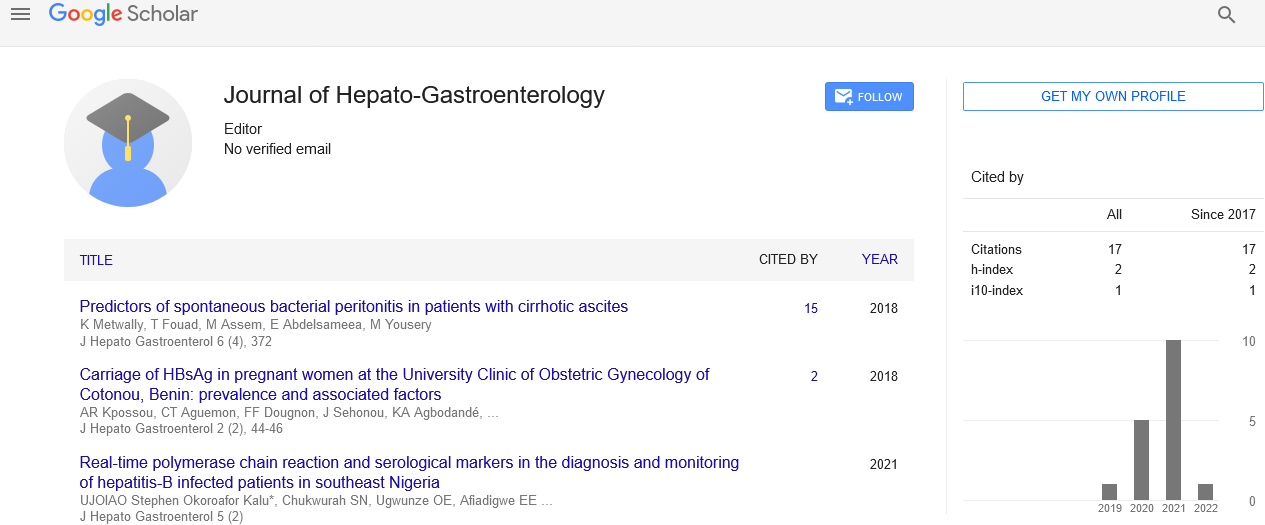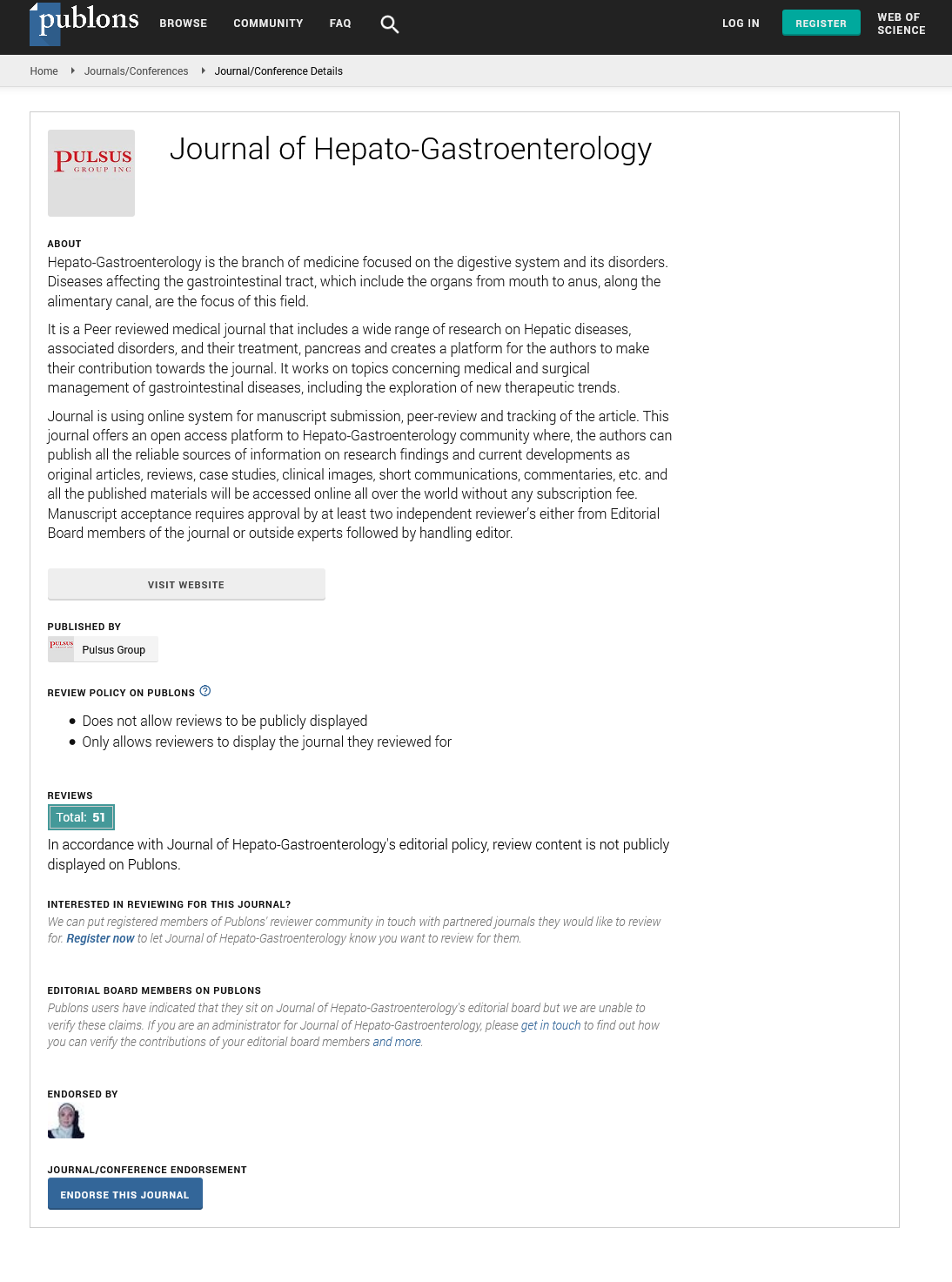Ascites as an atypical manifestation of Crohn窶冱 disease
2 Students of Medical University Nilton Lins, Manaus, Amazonas, Brazil, Email: GabrielPacifico90@yahoo.com
Received: 19-Sep-2018 Accepted Date: Nov 19, 2018; Published: 26-Nov-2018
Citation: De Araujo ARS, Nunes GPS, Chixaro JD, et al. Ascites as an atypical manifestation of Crohnテδ「テやぎテや┐s disease. J Hepato Gastroenterol. 2018;2(2):54-5.
This open-access article is distributed under the terms of the Creative Commons Attribution Non-Commercial License (CC BY-NC) (http://creativecommons.org/licenses/by-nc/4.0/), which permits reuse, distribution and reproduction of the article, provided that the original work is properly cited and the reuse is restricted to noncommercial purposes. For commercial reuse, contact reprints@pulsus.com
Abstract
Crohn’s Disease (CD) is an inflammatory bowel disease that potentially may affect any part of the gastrointestinal tract (GIT). Most common clinical aspects include diarrhea, abdominal pain, weight loss and fatigue, and also extraintestinal manifestations may occur. Despite the varied clinical picture, ascites is very unusual, with few case reports of CD associated with ascites in literature. We present a case from a 27-year-old female patient who developed voluminous ascites and, after diagnostic investigation, CD diagnosis was made. The main cause of ascites was a protein-losing enteropathy.
Keywords
Crohn’s Disease; Ascites; Diarrhea
Introduction
Crohn’s Disease (CD) is an inflammatory bowel disease that potentially may affect any part of the gastrointestinal tract, from the mouth to the anus. Etiopathogeny remains uncertain, but it is known that CD is associated with several complications, such as fistulas and abscesses [1-6]. Most common clinical aspects include diarrhea, abdominal pain, weight loss and fatigue. Extraintestinal manifestations such as uveitis, iritis, arthritis and arthralgia are also possible [1-6]. Despite being a disease with a varied clinical picture, ascites is very unusual. In literature, few cases of CD are reported as associated with ascites. Most of those cases are a result from disease complications, however, some remain a mystery to current medicine. This article aims at reporting one case of Crohn’s Disease with this atypical association [7-18].
Case Report
Female, 27 years old, developed a sudden condition of abdominal pain in the right hypochondrium and epigastrium, diarrhea with melena and yellowish vomiting with food remains. After a few hours, it progressed with worsening of pain, abdominal distension and vomiting. She went to the local hospital and the doctor decided she needed an emergency laparotomy because of the clinical features of intestinal occlusion and evolution of the abdominal pain, distension and vomiting. During surgery, voluminous ascites with citrine aspect and jejunum loop with infiltrated and thickened aspect were observed. No analysis of the fluid was made during that time. She remained hospitalized until she could bear a soft diet. She progressed with partial symptom improvement, remaining with mild abdominal pain, diarrhea with food remains, and no vomit and accepting a soft diet. After 30 days, symptoms were accentuated again, with associated ponderal loss of 20 kg, asthenia and intolerance to oral diet. She was hospitalized again, with lab tests shown in Table 1. Upper gastrointestinal endoscopy was performed, indicating pangastritis, duodenite and sparse erosive injuries in the second part of the duodenum. An ultrasound was requested, showing normal liver, kidneys with hydronephrosis grade I to the left and grade II to the right, fluid in the lower abdomen and small amount of fluid in the hepato-renal area.
| Tests | Results |
|---|---|
| Red Blood Cells | 8.7 |
| Hematocrit | 25.8 |
| White Blood cell count | 3,05,000 |
| Platelets | 5,920 |
| Urea | 17 |
| Creatinine | 0.87 |
| Sodium | 143 |
| Potassium | 1.9 |
| Albumine | 2.7 |
| TAP | 14.3 |
| INR | 1.1 |
| GOT | 44 |
| GPT | 39 |
| Gamma GT | 110 |
Table 1: Lab tests results
Since there was just a small amount of fluid, no paracentesis was made because of the risk of intestinal lesion. Therapy with ciprofloxacin, metronidazol, omeprazol and metoclopramide was initiated for 15 days. Nasoenteral probe was inserted for supplementation of 100 ml slowly; however, patient had post-prandial vomiting and diarrhea. Colonoscopy was requested; however, patient had worsening of symptoms, and was not able to peform the exam. A rectosigmoidoscopy was made showing unspecific colitis. After electrolytic correction, the patient showed partial improvement, however, not accepting food. New upper gastrointestinal endoscopy showed moderate enanthematous pangastritis, stenosis in the second portion of duodenum, preventing the probe passage. Hydrocortisone was initiated for 3 days, with which she showed improvement in the acceptance of liquid food. Feeding via nasoenteral probe, in small amount, was restarted. Hydrocortisone was replaced with prednisone 40 mg. After 3 days, the patient progressed well, accepting soft meal to then light oral meal. She was discharged with prescription for prednisone, omeprazol, ondasetron and referral to gastroenterology department, where she continues to have regular follow-up, with total improvement of symptoms.
Discussion
In this case, the diagnosis of CD was based on clinical aspects; surgery finding - jejunum loop with infiltrated and thickened aspect and endoscopic findings - stenosis in the second portion of duodenum in the gastroscopy and colitis in the rectosigmoidoscopy. In the report above, it is presented a case of CD associated with voluminous ascites. That association is very unusual, with few reports in global literature (7-10). Most cases reported are due to causes that are secondary to CD, such as gastrointestinal perforation, portal vein thrombosis due to hypercoagulability, tendency to development of malignancies, such as lymphomas and protein-losing enteropathy (PLE) [7-18]. In that case, we observe that the patient showed intense diarrhea during most part of her clinical picture, associated with major hypoalbuminemia. That makes us believe that the most probable cause of ascites was a PLE, which caused albumin depletion, thus causing the formation of ascites [7,16-18]. The diagnosis of PLE is based on history and physical examination. The request of others laboratory test such alpha-1-antitrypsin can be made in doubtful cases.
Conclusion
Since the patient showed symptoms as diarrhea and an important hypoalbuminemia; and CD can cause PLE by enhancing the leakage of protein-rich fluids across the eroded mucosa [19]; the diagnose was made only by the clinical picture presented that is a major point in the case, because it is not commonly associate with CD, the ascites, in the presented case, was a confounding factor in the diagnosis of the patient and led her to be subjected to unnecessary therapeutic measures, such as the exploratory laparotomy.
Author Disclosure Statement
The authors declare no conflicts of interest related to this article.
Funding
No funding was received for the development of this work
Author’s Contributions
G.P.S.N: wrote the article; J.O.C: collected the patient’s data; J.A.B.H.J: Patinent’s doctor and also helped to collect the patient’s data; A.R.S.A: wrote the article.
REFERENCES
- Gomollon F, Dignass A, Annese V, et al. 3rd European Evidence-based Consensus on the Diagnosis and Management of Crohn’s Disease 2016: Part 1:Diagnosis and Medical Management. J Crohn’s Colitis. 2017;3-25.
- Gionchetti P, Dignass A, Danase S, et al. 3rd European Evidence-based Consensus on the Diagnosis and Management of Crohn’s Disease 2016:Part 2:Surgical Management and Special Situations. J Crohn’s Coli. 2017;135-149.
- Ooi CJ, Makharia GK, Hilmi I, et al. Asia Pacific Consensus Statements on Crohn’s disease. Part 1:Definition, diagnosis and epidemiology. J Gastro Hepato. 2016;45-55.
- Ooi CJ, Makharia GK, Hilmi I, et al. Asia Pacific Consensus Statements on Crohn’s disease. Part 2: Management. J Gastro Hepato. 2016;56-68.
- Laass MW, Roggenbuck D, Conrad K. Diagnosis and classification of Crohn’s disease. Autoimmuni Rev. 2014;467-471.
- Ye BD, Yang SK, Cho YK, et al. Clinical features and long-term prognosis of Crohn’s disease in Korea. Scandi J Gastro. 2010;45:1178-1185.
- Kia R, White D, Sarkar S. An unusual presentation of fistulating Crohn’s disease: Ascites. World J Gastrointest Endosc 2010;2:41-43.
- Lee JU, Kim YH, Lee SY, et al. Does Ascites mean more severe Crohn’s Disease?. Korean J Gastroenterol. 2004; 43:304-308.
- Tekin F, Vatansever S, Ozütemiz O, et al. Severe exudative ascites as an initial presentation of Crohn’s disease. Turk J Gastroenterol. 2005;16:171-173.
- Paspatis GA, Kissamitaki V, Kyriakakis E, et al. Ascites associated with the initial presentation of Crohn’s disease. Am J Gastroenterol. 1999;94:1974-1976
- Tsujikawa T, Ihara T, Sasaki M, et al. Effectiveness of combined anticoagulant therapy for extending portal vein thrombosis in Crohn’s disease. Report of a case. Dis Colon Rectum. 1996;39:823-82.
- Maconi G, Bolzacchini E, Dell’Era A, et al. Portal vein thrombosis in inflammatory bowel diseases: a single-center case series. J Crohn’s Coli. 2012;362-367.
- Sinagra E, Aragona E, Romano C, et al. The role of portal vein thrombosis in the clinical course of inflammatory bowel diseases: A report on three cases and review of the literature. Gastroentero Practi. 2012.
- Scjouten JNL, Verheij J, Seijo S. Idiopatic non-cirrhotic portal hypeetension: A review. Orphanet J Rare Dis. 2015;10:67.
- Valdivieso CL, Naves JE, Mañosa M, et al. Hipertensión portal en pacientes con enfermedad inflamatoria intestinal. Gastroenterol Hepatol. 2010;33:297-302.
- Ferrante M, Hertogh D, Penninckx F, Assche GV. Protein-losing enteropathy in Crohn’s disease. Cli Gastroentero Hepato. 2005;3.
- Lee HJ, Rha MY, Cho YY, et al. Acase of protein supplement effect in protein-losing enteropathy. Clin Nutr Res. 2012;94-98.
- Perosio PM, Brooks JJ, Saul SH, et al. Primary intestinal lymphoma in Crohn’s disease: minute tumor with a fatal outcome. Am J Gastroenterol. 1992;87:894-898.
- Braamskamp MJAM, Dolman KM, Tabbers MM. Protein-losing enteropathy in children. Eur J Pediatr. 2010;169: 1179-1185.






